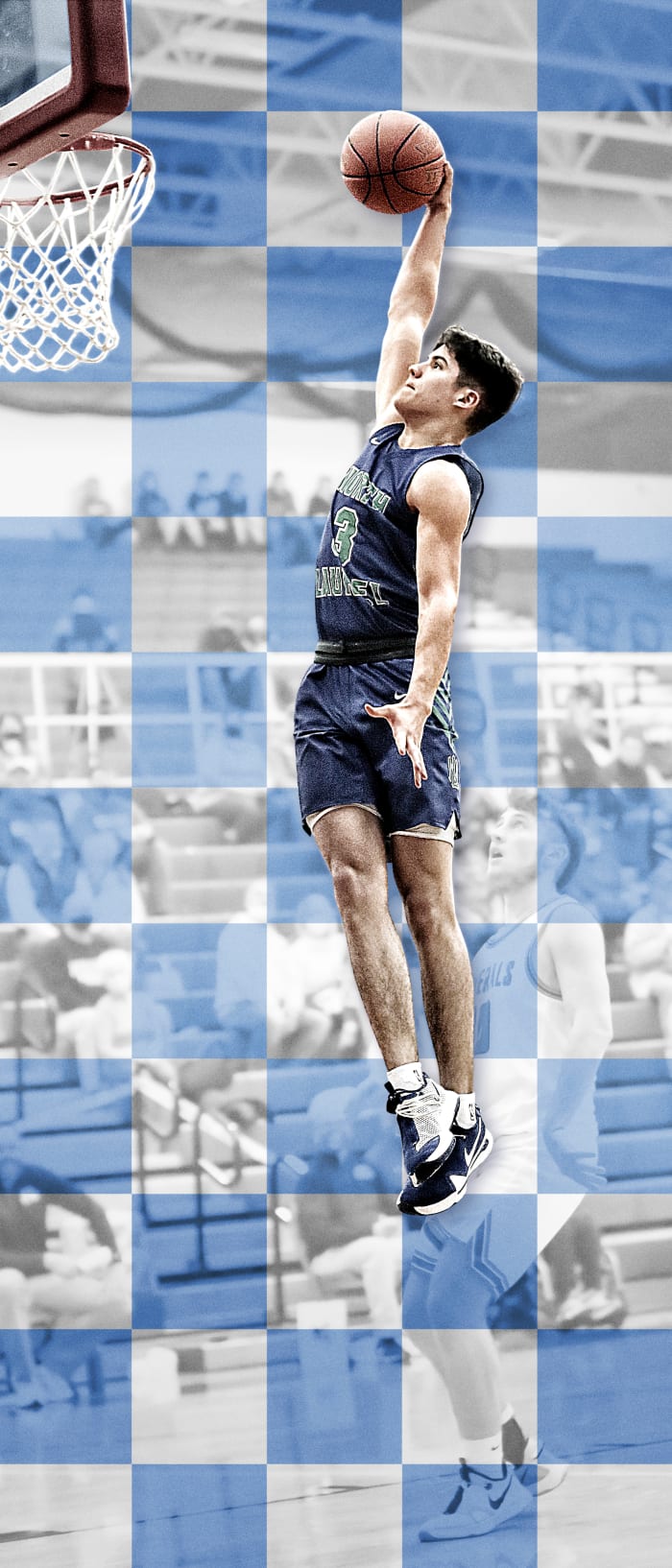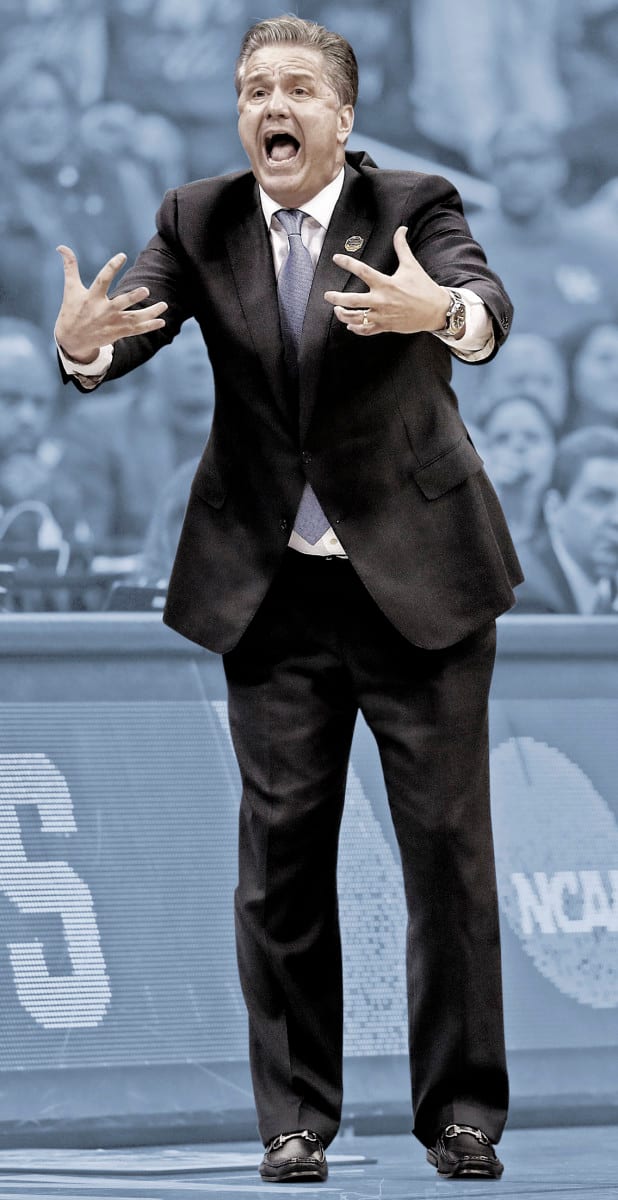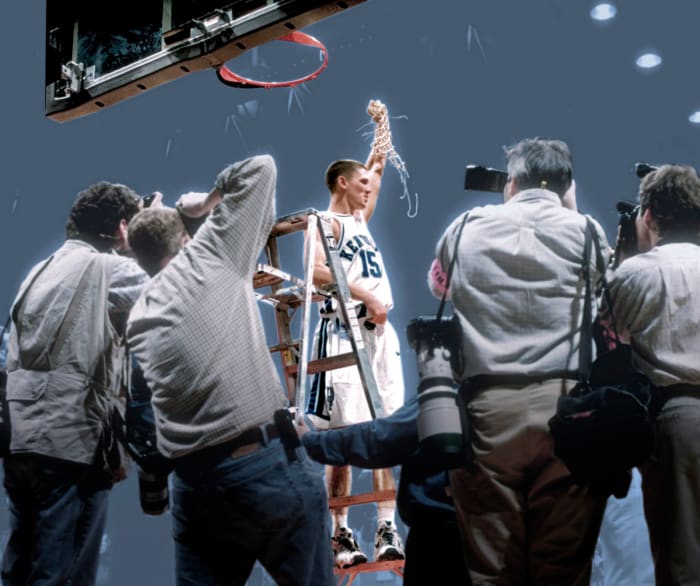Big Blue-Chip Blues

STAR OUTBURST: Sheppard had two 50-point games—one a triple double—in a week in early February.
COURTESY OF LES NICHOLSON/THE SENTINEL ECHO; PHOTO ILLUSTRATIONS BY DAN LARKIN
The green letters on the electronic sign beside Hal Rogers Parkway flash WELCOME TO THE JUNGLE. But North Laurel High, home of the Jaguars, exudes a serene vibe on this February evening. Nothing wild seems to be happening here.
The surrounding hillsides are blanketed in snow and cold and quiet, and the pickup-dotted parking lot behind the gym is less than half-full. The best show in Laurel County, in the entire basketball-mad state of Kentucky, is available for limited in-person viewing.
Inside the gym, the 14-member North Laurel pep band is bleating out an endearingly threadbare version of “Sweet Caroline.” This is a trusty audience participation tune, but there is not much audience and even less participation—an arena that seats 2,200 has fewer than 200 fans in it. “If it weren’t for COVID, we would be standing-room-only every game,” says coach Nate Valentine.
Laurel Countians badly want to see their Jaguars, 17–0 and ranked No. 2 and leading the state in scoring at 90.4 points per game. Most of all, they’re eager to gauge the game of the team’s point-guard prodigy, the son of two University of Kentucky greats, sophomore Reed Sheppard. Everyone is impatiently waiting to witness the biggest basketball recruit to come out of the mountains of eastern Kentucky in decades—and to see whether he can bring about a change in the increasingly unpopular way the Wildcats’ roster is constructed.
The son of Jeff and Stacey Sheppard—the Most Outstanding Player of the 1998 men’s Final Four and a top-15 career scorer in the women’s program at UK—is routinely blowing up box scores. He is averaging a state-leading 32.7 points per game, twice scoring more than 50. He’s had multiple triple doubles, including one with 17 assists. But it’s happening against modest competition, in a sparsely populated part of the state, amid a shutdown.
For now, Sheppard is an echo, a word-of-mouth myth wrapped in COVID-19 mystery. In a world where young basketball talents tend to be overexposed by age 16, here comes one with a rare element of suspense. The 2020 AAU circuit barely existed, and college coaches still haven’t been permitted to go on the road to see prospects. Recruiting websites barely have a book of any kind of the 6' 2" point guard.
The statistics and highlight videos and bloodlines have built the hype, but will it turn out to be real? And if it is real, will Kentucky coach John Calipari halt the one-and-done NBA assembly line—which rarely shops for in-state parts—to make a scholarship offer to Sheppard? “It’s going to be the big story of the next couple years,” says longtime Lexington Herald-Leader columnist John Clay. “Is Cal going to recruit him? How hard is he going to recruit him? And is he going to get him?”
It is here, in this Appalachian town of about 8,000 deep in Big Blue country, where the next referendum on Calipari’s increasingly ineffective and locally unpopular recruiting philosophy could play out. The path to college basketball national championships the past five years has been to “get old and stay old,” to use the term currently popular with coaches. Old is 21 and 22, young is 18 and 19. The young guys who view UK as an NBA stopover have stopped delivering titles for Calipari, who last led a team to the Final Four in 2015 and whose current team put up the school’s first losing season in 32 years. So is he willing to try a different approach? And could that different approach start with a legacy recruit from a region of the state that has always been politically complicated for coaches of the Cats?
In the "jungle," the final score is North Laurel 87, Whitley County 46. I have Reed with 19 points on just 14 shots, nine rebounds, 14 assists and six steals, though the official statistician—a fill-in—has him with just five boards and 11 dimes. Either way, the Jaguars are a symphony of modern hoops, moving the ball quickly in transition for open three-pointers or drives to the basket. Sheppard is the conductor, working most closely with his cousin and lifelong teammate, Ryan Davidson, exhibiting an ambidexterity and court awareness very rare for a high school sophomore.
“I assumed he’s typical small-town Kentucky, shoots 30 times a game to score 40 points,” says a Division I coach who has seen Sheppard play. “That’s not the case. The thing that separates him [is that] he makes every right decision, he doesn’t force and he can make every right read of the defense. And he really finishes. He’s good enough to play there.”
By there he means, of course, at Kentucky.
Jeff was part of the Wildcats’ greatest run since the 1950s, winning national titles in 1996 under Rick Pitino and two years later under Tubby Smith. He was a bouncy, burr-headed guard playing a role on loaded teams, but he became the star of the ’98 title run: His 27 points in the national semifinal led Kentucky out of a double-digit hole to beat Stanford in overtime, then he added 16 in a comeback win over Utah in the championship game.
Devout and quietly intense, Sheppard fell in love in college with bubbly country girl Stacey Reed, whose twangy accent makes it very clear where she’s from. She was the hyperactive engine of the women’s team, hands and feet moving all the time, quick to smile but quicker to steal the ball from a casual opposing guard. After Jeff’s professional career—which included 18 games with the Hawks and three seasons in Italy—the couple moved back to Stacey’s childhood stomping grounds in Laurel County.
In terms of playing style, Jeff thinks Reed plays more like his mother than like him. They do share a point-guard mentality and high basketball IQ. But Stacey says she can only wish she had his floor vision and instincts. “How he sees the court, he’s a whole ’nother creature,” she says. “A play ahead, I could see it. But he’s on a different level. He just has a natural feel for the game, and he’s played with these guys for so long.”
The current North Laurel team includes half a dozen members of youth-league teams that Reed played on and Jeff coached. High school basketball has never been more transient—prep schools, pop-up Christian schools, transfers aplenty—but the Jaguars are a throwback, homegrown team. Reed’s parents aren’t inclined to be the ones to break up this merry band. In an era when high-level prospects often move around in search of high-profile programs built around collections of star players from all over the country, they’re happy watching their only son play with his grade-school pals.
“We do hear that,” Stacey says about possibly moving so Reed could play somewhere else. “But we feel the exposure he gets through AAU, he’s going to get all he needs through that. It’s hard to find the close-knit relationships they have. The memories and relationships and experiences they can create with each other, I don’t want to pull him away from that.
“I think there’s a lot to be said when you’re committed to your hometown, a loyalty to where you’re from. People respond and react and follow you, so it doesn’t just last when you’re in high school. The Londonites are going to be following them wherever they go.”
Of course, where Reed goes after London already is the subject of intense local interest. It’s the story line that looms over everything he does, even while he’s just trying to enjoy a dream season with his childhood buddies.
Let it be known that John Calipari himself has spoken by phone with the Sheppards. He’s not alone; so has Virginia’s Tony Bennett, Louisville’s Chris Mack and Indiana’s Archie Miller, among others. But before Big Blue Nation gets too angsty about it, rest assured that Cal has made an overture.

DECLAWED: Calipari’s Cats went 8–9 in conference play, the program’s worst mark since 1989.
DAVID E. KLUTHO
Only five schools have offered scholarships to date: Iowa, Stetson, South Alabama, Iona and High Point. (The latter two are led by Jeff’s former UK coaches, Pitino and Smith.) That number figures to escalate in the spring and summer, when Sheppard suits up for an AAU team from Cincinnati on the Adidas circuit and when recruiting opens up again.
Jeff and Stacey would like to stay out of Reed’s college decision no matter what it is. They won’t be pushing their alma mater. “I think it’s important for Reed to know that even though Jeff and I played there and had a great time there, he’s different,” Stacey says. “He’s doing his own thing. He knows that we don’t care where he goes.”
If Calipari does extend an offer, it will be welcomed. But it might not be accepted on the spot.
“It’s every kid in Kentucky’s dream to play at the University of Kentucky,” Reed says. “But just letting it play out. . . . God will put me where He wants me to be, a place where I feel at home and the people feel like family.”
The backdrop for this recruiting saga is the conflicted history of in-state stars and Kentucky—especially an in-state star from the mountains. The Wildcats have been led to national titles by several natives of the state, from Wallace (Wah Wah) Jones and Ralph Beard in the 1940s to Jack Givens in 1978. Louisville’s Derek Anderson was a key contributor to the ’96 title team, and Darius Miller filled a similar role on Cal’s 2012 title team. But there also have been plenty of players who were passed over (to the outrage of the fans) or who played little after becoming Wildcats (which also produced outrage).

NET GAIN: Jeff Sheppard averaged 13.7 points per game as a senior and won his second national title.
JOHN BIEVER
The ultimate lightning-rod recruit was mountain hero Richie Farmer, who led Clay County to the 1987 state championship. His celebrity grew to the point that the road outside his home in the coal-mining town of Manchester was renamed “Richie Boulevard,” and his scoring duels with future NBA star Allan Houston of Louisville Ballard were the stuff of legend. (Farmer scored 51 in a losing effort in a championship rematch in ’88.)
There was nearly a populist revolt when it appeared that Kentucky coach Eddie Sutton wouldn’t recruit him. The 5' 11" Farmer was a tweener guard—not enough of a distributor to play the point, and too short to play the two. Sutton unenthusiastically had signed a pair of natives from “out in the state” the year before, John Pelphrey and Deron Feldhaus, but Farmer was the true people’s-choice recruit.
Finally, after a recruiting visit from LSU’s Dale Brown upped the ante, Sutton offered Farmer a scholarship. “Sutton made it seem like it was a burden,” says Rick Bozich of WDRB in Louisville, who has covered basketball in Kentucky for more than 40 years. “In a world with no critics, I don’t think he would have taken Richie.”
Bozich and others think Calipari is less likely to listen to what the fans want. But as this disastrous losing season has unfolded at Kentucky, the fans have increased the volume of their discontent with Calipari’s program-building philosophy. A one-and-done revolving door was never an ideal construct for many fans of the program that once had the most special Senior Day ceremonies in the country. But the fans made a Faustian bargain: We’ll take it as long as we’re winning big.
They’re no longer winning big, though. Or, this season, even winning more than they lose.
For a while, it appeared that the NBA was poised to disrupt the one-and-done machinery by lowering its mandatory age limit. That would have allowed high school players more direct access to the NBA, which would force a change to the way Calipari and others have approached recruiting. But there is far less talk about that now, especially since the G League has developed an alternative to college.
So the opportunity for one-and-done team-building may still exist for quite a while. That may not thrill Kentucky fans, who have seen 28 one-and-dones since the Calipari era began in 2010 (25 were first-round picks). “There’s one-and-done fatigue,” says the Herald-Leader’s Clay. “The grumbling has increased every year.”
Can Reed Sheppard—a legacy recruit, a homegrown talent, a mountain boy and a player who looks at Kentucky as something more than just a nine-month stop on the way to the pros—force a change in Calipari’s approach?
“It should change the dynamic,” Bozich says. “The percentage of Kentucky fans who want Reed Sheppard to play for Kentucky has to be close to 100%. I think people are hungry for an in-state guy. It has to be tiresome every year to learn the names and invest in their backstories, and by the time you know who they are, they’re gone.”